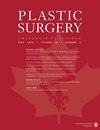评估整形外科的虚弱程度:五因素指数分析
IF 0.7
4区 医学
Q4 SURGERY
引用次数: 0
摘要
背景:在多个外科专科中,虚弱已被证明与不良预后密切相关。然而,直到最近才有人研究了它与整形外科的相关性,但得出的结果并不一致。我们的目标是在整形外科手术的多个子类别中应用五因素改良虚弱指数(mFI-5),以确定它可能证明有用的潜在领域。方法:利用 2015 年至 2019 年的 NSQIP 数据。根据以下常见手术分组,将整形外科 CPT 代码归入临床相关的子类别:浅表软组织手术、头颈部重建、手部手术、乳房重建、性别手术、美容手术和面部骨折。每个子类别都计算了 mFI-5 分数。C统计量用于确定30天发病率的预测能力。此外,还计算了多变量逻辑回归,以评估与 30 天发病率有关的几率比 (OR)。结果:共有 188741 名患者符合纳入标准。整形外科患者的平均虚弱程度低于其他外科专科。C统计量模型和ORs显示,mFI-5对浅表软组织手术(C统计量:0.758)、手部手术(C统计量:0.832)、乳房重建(C统计量:0.718)、头颈部重建(C统计量:0.735)和性别手术(C统计量:0.732)的术后并发症具有预测能力。结论mFI-5 是一种临床工具,可有选择性地、谨慎地用于整形外科的特定子类别手术,包括软组织手术、手部手术、头颈部重建和乳房重建。本文章由计算机程序翻译,如有差异,请以英文原文为准。
Assessing Frailty in Plastic Surgery: Analysis of the Five-factor Index
Background: Frailty has been shown to have a strong association with adverse outcomes in several surgical specialties. Only recently, however, its relevance in plastic surgery has been examined, yielding inconsistent results. Our goal was to apply the five-factor modified frailty index (mFI-5) across multiple subcategories of plastic surgery procedures to identify potential areas where it might prove useful. Methods: NSQIP data from 2015 to 2019 were utilized. Plastic surgery CPT codes were placed into clinically relevant subcategories based on common procedure groupings as follows: superficial soft tissue procedures, head and neck reconstruction, hand surgery, breast reconstruction, gender surgery, esthetic surgery, and facial fractures. The mFI-5 score was calculated for each subcategory. C-statistics were used to determine predictive ability for 30-day morbidity. Multivariable logistic regressions were also calculated to assess for odds ratios (ORs) with regard to 30-day morbidity. Results: A total of 188,741 patients fit inclusion criteria. The mean frailty of plastic surgery patients was noted to be lower than in other surgical specialties. C-statistic models and ORs showed mFI-5 to have predictive ability for post-operative complication in superficial soft tissue procedures (C stat: 0.758), hand surgery (C-stat: 0.832), breast reconstruction (C-statistic: 0.718), head and neck reconstruction (C-statistic: 0.735), and gender surgery (C-statistic: 0.732). Conclusion: The mFI-5 is a clinical tool that can be selectively and cautiously used in plastic surgery, for specific subcategories of procedures including soft tissue procedures, hand surgery, head and neck reconstruction, and breast reconstruction.
求助全文
通过发布文献求助,成功后即可免费获取论文全文。
去求助
来源期刊

Plastic surgery
Medicine-Surgery
CiteScore
1.70
自引率
0.00%
发文量
73
期刊介绍:
Plastic Surgery (Chirurgie Plastique) is the official journal of the Canadian Society of Plastic Surgeons, the Canadian Society for Aesthetic Plastic Surgery, Group for the Advancement of Microsurgery, and the Canadian Society for Surgery of the Hand. It serves as a major venue for Canadian research, society guidelines, and continuing medical education.
 求助内容:
求助内容: 应助结果提醒方式:
应助结果提醒方式:


